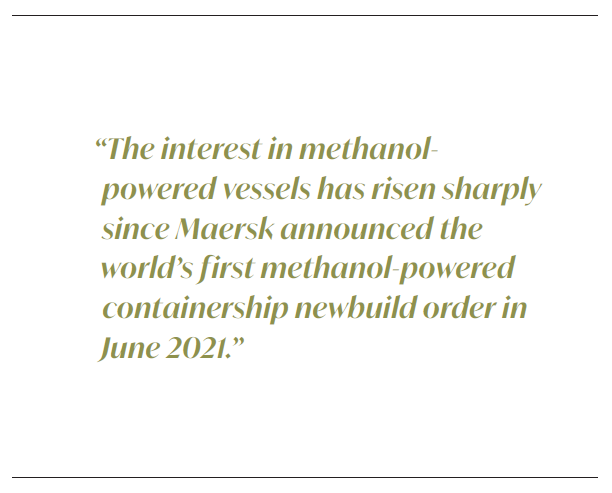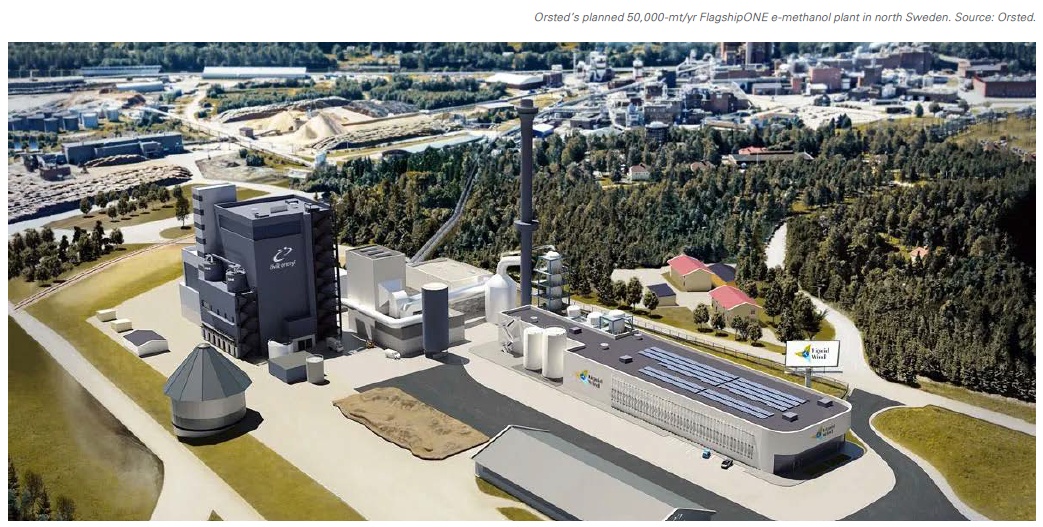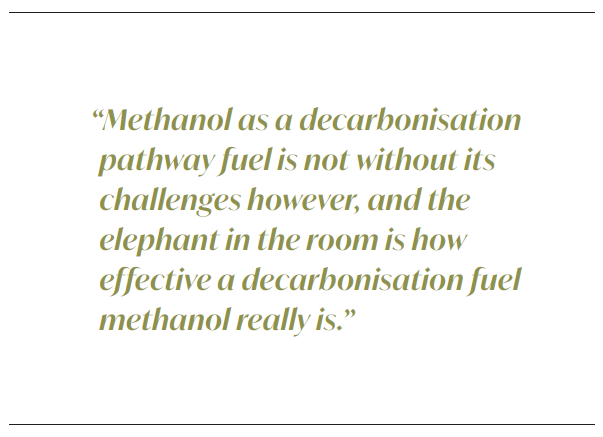More than meets the eye for methanol as a bunker fuel [Gas in Transition]
Among the various solutions being proposed to meet the challenge of decarbonising the shipping industry, the use of methanol as a bunker fuel is emerging as an increasingly popular choice.
The cleaner burning fuel certainly has its advantages when compared to other alternative fuels – its use and transportation in shipping is well-established and the technology and systems used are mature, as is availability at ports.
As a result, classification societies such as Bureau Veritas and DNV have readily accepted methanol dual-fuelled vessels and this has resulted in a steady number of newbuildings being ordered.
In fact, according to DNV figures, October 2022 was the first time methanol-fuelled newbuildings outnumbered that of liquefied natural gas-fuelled newbuildings.
This was driven by landmark orders such as a combined total of 18 containership orders from major lines Maersk, Cosco Shipping Lines and its subsidiary OOCL. These are set to be delivered between 2026 and 2028.
To be built at South Korean and Chinese shipyards Hyundai Heavy Industries and Nantong Cosco KHI Ship Engineering and Dalian Cosco KHI Ship Engineering respectively, the six from Maersk, seven from OOCL and five from Cosco brings the number of methanol-fuelled containerships on order and in operation to 47, according to DNV’s Alternative Fuel Insights.
There are also 25 methanol-fuelled oil or chemical tankers on order and in operation and other segments such as offshore renewables and dry bulk are also starting to express interest in using the alternative fuel to help them decarbonise.
Companies including top methanol producer Methanex's shipping subsidiary Waterfront Shipping, No 2 producer Proman with its shipping partner Stena Bulk, and Japanese majors NYK and MOL have built a series of methanol carriers that use part of the cargo as fuel.
In the offshore renewables sector, SAL Heavy Lift and partner Jumbo Shipping have ordered four heavy-lift vessels that will be built with methanol dual-fuel engines, with the first two scheduled for delivery in 2024.
Overall there are 20 dual-fuel methanol vessels in operation, mostly run by Waterfront Shipping at the moment, with 64 on order. Maersk's 19 vessels on order and other orders from major container lines such as CMA-CGM and X-Press feeders comprise a large proportion of that. Based on current orders and delivery dates, the global dual-fuel methanol fleet will almost triple in size by 2024, jumping from 20 to 58.
Meanwhile, Methanex tells NGW that based on orders, it expects that about 100 or more dual-fuel methanol vessels will be on the water by 2026-2027.
"These figures are likely conservative based on other intelligence (and)engines on order by OEMs for vessels not publicly announced," Methanex adds.
The story so far
The interest in methanol-powered vessels has risen sharply since Maersk announced the world’s first methanol-powered containership newbuild order in June 2021, declaring at the time that it saw green methanol as a fuel of the future and putting the industry on the path to achieving its goals to reduce its environmental impact.
In recent months, the big Chinese players, with their massive fleets, have also come aboard the methanol bandwagon. In a meeting with the Methanol Institute on the shipping industry's low-carbon transition, the chairman of China Merchants Energy Shipping and Cosco Shipping Bulk, said their companies will focus on methanol bunker as their "primary area of research" in the future.
Meanwhile Vale is looking at a new generation of very large ore carriers that could see the construction of methanol-fuelled dry bulk carriers as well.
The Brazilian mining giant has reportedly asked companies for proposals for its so-called Guaibamax 325,000-dwt vessels that would run on methanol and could include additional fuel-saving technologies such as rotor sails.
Vale is not averse to innovating in order to maximise efficiency and reduce costs on its typically super long haul voyages shipping iron ore from Brazil to China. It introduced the 400,000-dwt Valemax vessels in 2011, currently the largest dry bulk carriers in operation.
Challenges and opportunities
Increasing use of methanol-fuelled ships should spur the development of more production facilities as well as encourage investments in bunkering infrastructure.
While the latter is less of a problem, with methanol being available at some 122 ports, the former is seen as a major impediment to the adoption of methanol as a bunkering fuel.
Due to methanol's relatively lower energy density, which is slightly less than half that of traditional heavy fuel oil, much more volume will need to be stored onboard and consumed to produce the same amount of output.
It is believed that there are only about 30,000 metric tons of methanol fuel currently being produced annually. Maersk estimates that when its new vessels come online, about 15 times that amount will be needed for just these vessels alone.
Methanex forecasts that potential demand from the shipping industry could rise from approximately 300,000 mt currently to 2mn mt over the next few years if all the existing and newbuilding vessels coming online are fully run on methanol.
Methanex however is optimistic about the prospects of the industry meeting the new demands.
"Methanol has the potential to add significant supply to the marine fuel industry," it says.
"Methanol is already a large global commodity chemical and fuel and hence we would expect the supply side to grow to match new demand," Methanex added.
High global energy prices also enhance methanol's cost competitiveness against alternative fuels, which could lead to increased methanol demand.
"We think certainly that the shipping companies are choosing methanol because of its clean-burning attributes as well as its future pathway to low carbon," said Paul Hexter, president of Methanex shipping subsidiary Waterfront Shipping.
"So we think that methanol has been the choice they've made because of that, and they are looking at and seeking the economics of methanol," Methanex adds.
The characteristics of methanol also require regulatory and safety protocols to be put in place for its use as a bunker fuel.
 Although methanol's liquid state at ambient temperatures and normal pressure is an advantage, it is nevertheless a toxic and flammable substance and special attention must be paid to the high toxicity of its vapours.
Although methanol's liquid state at ambient temperatures and normal pressure is an advantage, it is nevertheless a toxic and flammable substance and special attention must be paid to the high toxicity of its vapours.
DNV believes bunkering infrastructure and regulations are less of a problem as handling methanol is relatively straightforward compared with other alternative fuels, as it is already present in over 120 ports and is handled and bunkered very similarly to diesel.
On the regulatory side, DNV sees the new International Maritime Organisation (IMO) interim guidelines for ships using methyl or ethyl alcohol as a fuel, MSC.1/Circ.1621, along with the IMO IGF Code for ships using low-flashpoint fuels and its own mandatory class rules for methanol-powered ships as providing much greater clarity to shipowners considering investing in these vessels.
The available regulatory framework now provides a good foundation for designing, building and operating these ships, the absence of which had previously hindered investment decisions.
Meanwhile, the bunkering industry has also stepped up its game, with top bunkering ports from Singapore to Rotterdam putting in place both the regulatory framework and the infrastructure to facilitate methanol bunkering.
Rotterdam carried out the first barge-to-ship methanol bunkering in 2021.
Singapore announced at the Sibcon 2022 bunkering conference in October that Maersk, Mitsui and the American Bureau of Shipping would collaborate on a methanol bunkering trial in the first half of 2023. Separately, Singapore bunker trader Global Energy Trading has ordered the port's first dedicated methanol bunkering vessel.
Meanwhile other ports are also keen to get in on the game as they place their bets on which alternative fuel will emerge as the dominant one in the future.
The ports of Ulsan and Gothenburg at the end of 2022 announced plans to be low-carbon, methanol bunkering hubs for northeast Asia and northern Europe respectively.
The larger volumes involved also mean that costs of the fuel and storage capacity onboard need to be well-managed.
It is estimated that compared to conventional marine fuel, green methanol is twice as costly and dual-fuel newbuildings are 10% to 15% more expensive to build.
There are indications that the industry is stepping up to these needs.
There have been a rash of new methanol production facilities as well as increased production capacity at existing plants announced recently. Many of these have been driven by Maersk's commitment to a significant fleet of ocean going, globally trading methanol-powered containerships and the Danish shipping giant's desire to ensure sufficient supply for its upcoming fleet.
This includes Iberdrola's €1.1bn ($1.2bn) green hydrogen plant in Australia that will produce 300,000 mt/year of green methanol for bunker; Maersk's tie-ups with the Spanish government and various global partners to produce 2mn mt/yr by 2030 and 730,000 mt/yr by end-2025 respectively; and Orsted's FlagshipONE project in northern Sweden that will 50,000 mt/yr from 2025, among others.
Environmental value
Methanol as a decarbonisation pathway fuel is not without its challenges however, and the elephant in the room is how effective a decarbonisation fuel methanol really is.
Different production methods as well as measures of carbon emissions mean there are variations in the sustainability of methanol as a fuel, especially when considered on a well-to-wake basis.
"Methanol offers an immediate, in-sector (tank to wake) CO2 reduction of up to 15% when compared to conventional marine fuels," says Methanex, citing research from Stena.
According to Bureau Veritas, on a similar basis, using methanol sees an average 7% decrease in CO2 emissions as compared to high sulphur fuel oil.
Broadly, brown and grey methanol are made from coal and natural gas respectively and are therefore still essentially-fossil fuel derived.
Blue methanol is produced using blue hydrogen in combination with carbon capture technology, while green methanol may be bio-methanol produced from biomass or e-methanol produced from green hydrogen, captured CO2 and renewable electricity. Both these methods sharply reduce CO2 emissions on a lifecycle basis.
To assess the relative value and suitability of each type of methanol as a bunker fuel it is then necessary to look at the cost of production and the market for the respective types.
According to the International Council on Clean Transportation, blue methanol produces up to eight times more emissions than green methanol on a well-to-wake basis.
Green methanol on the other hand, while producing the least amount of emissions, also has the most working against it.
The shipping industry’s biggest obstacle with green methanol is sourcing it, says ICCT.
Although this is improving with recent investments, the green methanol industry is currently small and there are only a handful of commercial producers worldwide, resulting in high costs.
ICCT cited an American Bureau of Shipping 2021 report estimating the cost of green methanol at $643/mt. This puts it on the borderline in comparative costs against conventional fuels such as marine gas oil and very low sulphur fuel oil.
While its proponents are quick to highlight its advantages, the adoption of methanol as a marine fuel is not without its challenges and even its purported claims to significantly reduce CO2 emissions must be qualified.
Nonetheless, it remains a viable low carbon option for the shipping industry. Meanwhile production capacity and the resulting market conditions for green methanol in particular are changing rapidly and could turn favourable more quickly than expected as industry players react to demand.


.png_f1920x300q80.jpg)
